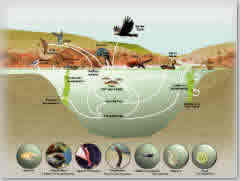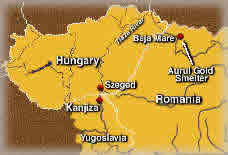Technical Support for Environmental Characterization, Risk Assessment, and Remediation of the BP/Amoco Refinery, Wyoming Department of
Environmental Quality, Casper, WY

Waterstone is currently providing scientific, regulatory, and public involvement support to the State of Wyoming in an accelerated, politically
charged and high public profile remediation project at the former BP/Amoco Refinery Site in Casper, Wyoming. The impacted areas include the
refinery, extensive tank farms, a playa lake and more than 1000 acres of wetlands, riparian areas, and terrestrial uplands along the North Platte
River.
Waterstone has been involved in supervising all phases of the development of the human health and ecological risk assessments for the refinery.
Waterstone’s responsibility is to review documents prepared by the potentially responsible party’s contractor, and to ensure that they are adequate
to meet the data quality objectives for delineation of nature and extent of contamination as well as for risk assessment. Waterstone reviewed RCRA
Facility Investigation Work Plans for each site, Sampling and Analysis Plans (SAPs), Quality Assurance Project Plans (QAPPs), risk assessment work
plans, draft and final risk assessments and other associated work plans governing the investigations for each site. Since all sites were different,
different sampling strategies were employed for each. Waterstone also provided oversight of field sampling and remedial activities
Waterstone also developed a Geographic Information System (GIS)-based Decision Support Tool (DST) for WDEQ that was used by both the PRP and regulators
to evaluate data adequacy, develop sampling strategies and evaluate remedial alternatives based on risk-based environmental and human health action levels.
The integrated GIS/database DST provides simple, site-specific dialogues to build consistent queries of the environmental database, and display
the results either as map layers in the GIS or data reports, graphs, histograms or charts in Access.
Waterstone has also worked with the WDEQ on the development of newsletters, public meetings and other outreach tools to communicate GIS, risk and toxicological
information to the public. Waterstone is currently supporting WDEQ for additional oversight services related to remediation work at the refinery.
Risk-based Site Remedial Investigation Feasibility Study, Milltown Superfund Sediment Site, Milltown, MT
Managed all aspects of a multi-million-dollar site investigation, risk assessment, and cleanup feasibility study for a metal mine waste National
Priorities List (NPL) site in Montana. This RF/FS became a risk-assessment driven investigation due to public involvement. The work included the
development of site-specific sampling programs for metals initially due to groundwater contamination, but also included surface water, sediments, soil
and biota. Sampling of domestic residences, gardens and biological sampling of human populations for arsenic and lead was also performed. The project
included a unique committee-driven risk assessment process for the site with significant public involvement and risk communication.
Cyanide Release, European Bank Consortium, Bia Mare, Romania
A Waterstone staff member was part of a five-member international team of experts sent to Bia Mare, Romania, to investigate the causes and potential
adverse effects from a cyanide release at a gold recovery operation. The release was one of the largest in Europe and had environmental impacts through
Romania, Hungary, and into the Black Sea. Waterstone’s staff investigated the scope of impact to human health and the environment due to free and metal-complexed
cyanide. The project involved evaluating groundwater, surface water, and fish tissue data to determine potential chemical concentrations and potential ecological
and human health effects with time and with distance from the spill.
Copper Smelter, USAID, Romania
In collaboration with Romanian counterparts and a team of more than 20 foreign consultants, Waterstone staff participated in a health risk assessment and a
hygiene behavior change program to reduce blood lead levels in children, design and implementation of an environmental monitoring program, and development of
a health and safety program for plant workers. The project succeeded in reducing child blood lead levels by 28%, despite the fact that the smelter continued to
operate.
Colorado Department of Transportation, Denver, CO – Material Testing Laboratory Remediation Program
Waterstone currently provides database management support for the Colorado Department of Transportation Materials Testing Lab environmental remediation program.
In addition to maintaining and updating both air and groundwater sampling results for some 450 discrete locations, Waterstone has developed a browser-based CD-ROM
that allows the broad range of project stakeholders to easily query sample data via an intuitive map-based interface. Using automated database update programs
developed by Waterstone, new versions of the CD-ROM based digital report with the most current data can easily be produced, allowing timely analysis of the changing
environmental conditions.